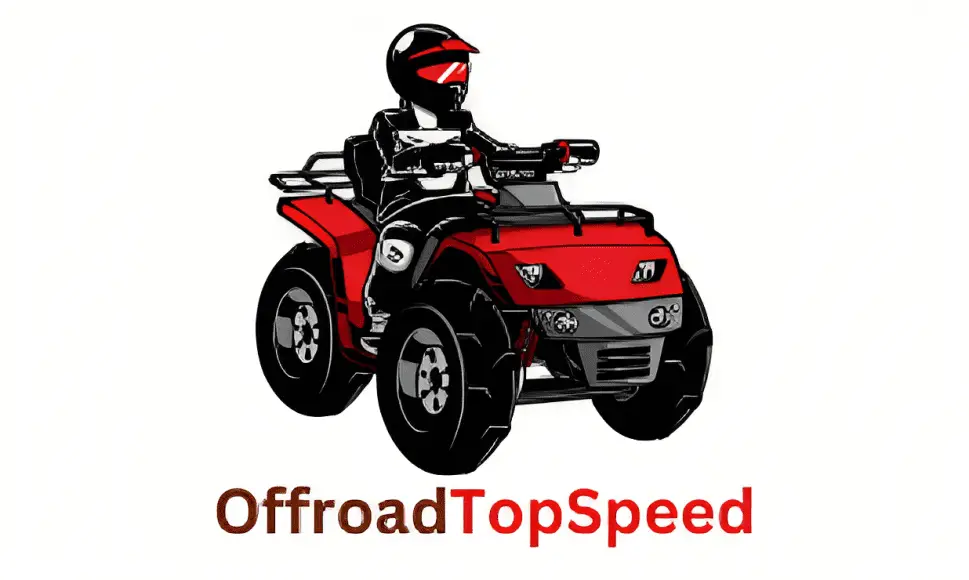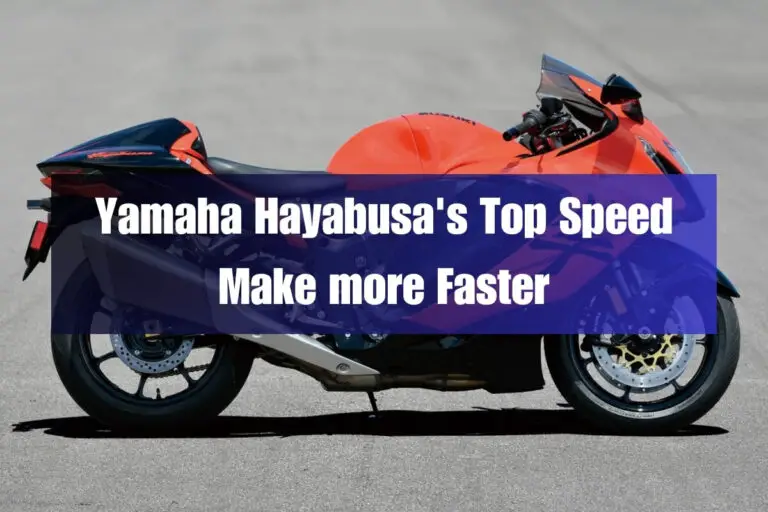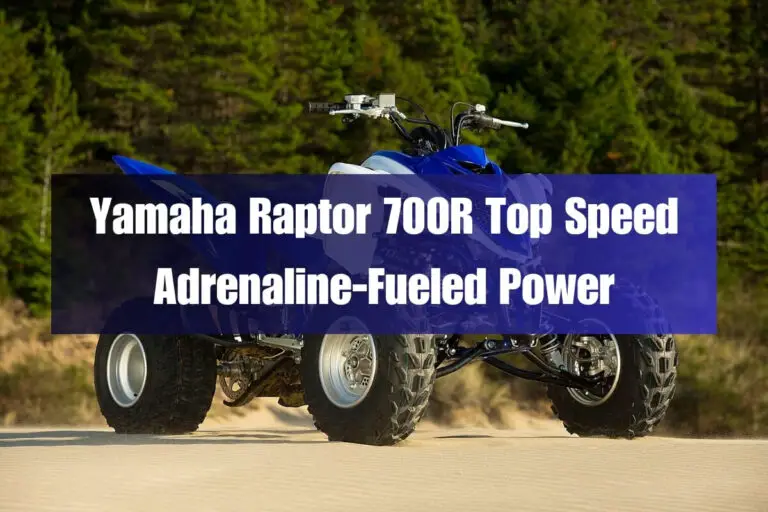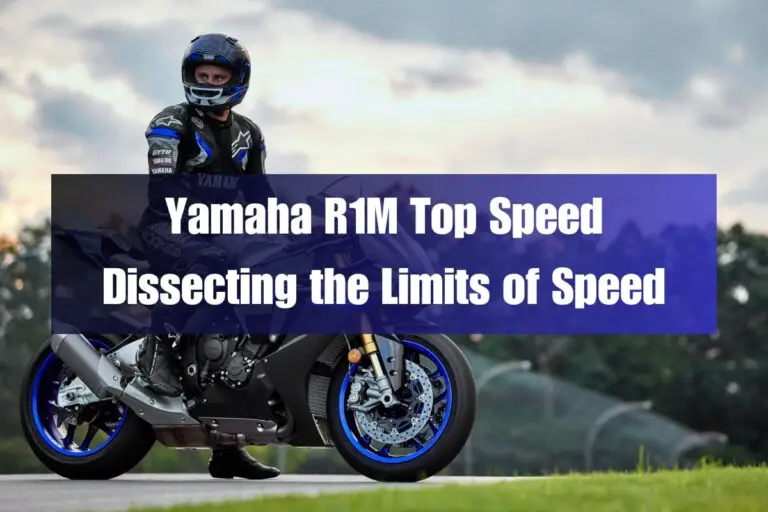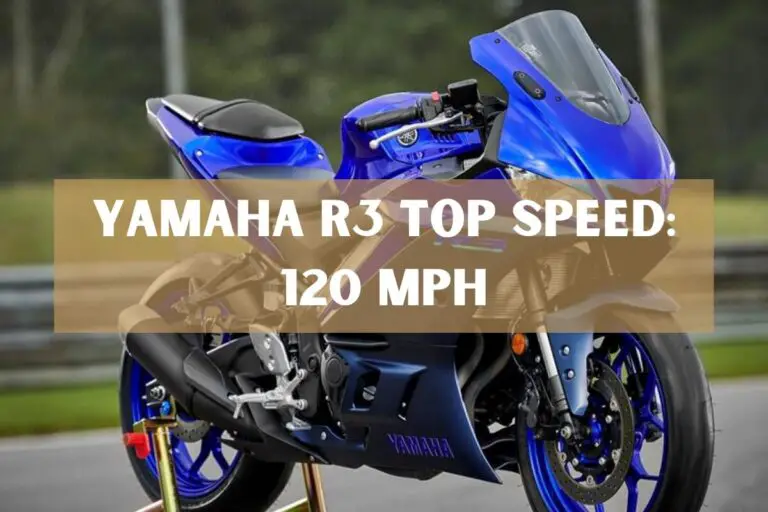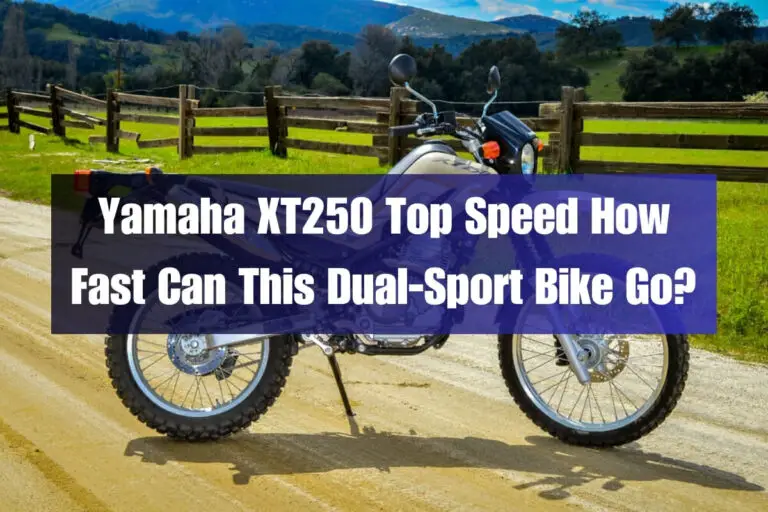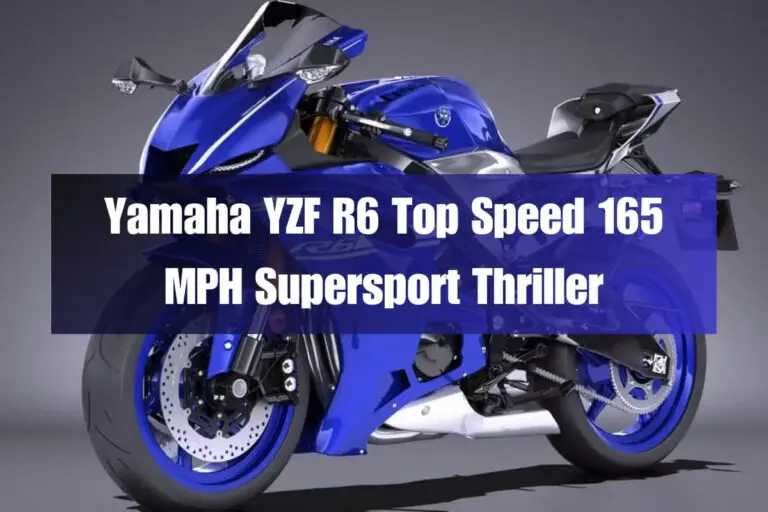Exploring the Yamaha YZF-R3’s Top Speed Capabilities
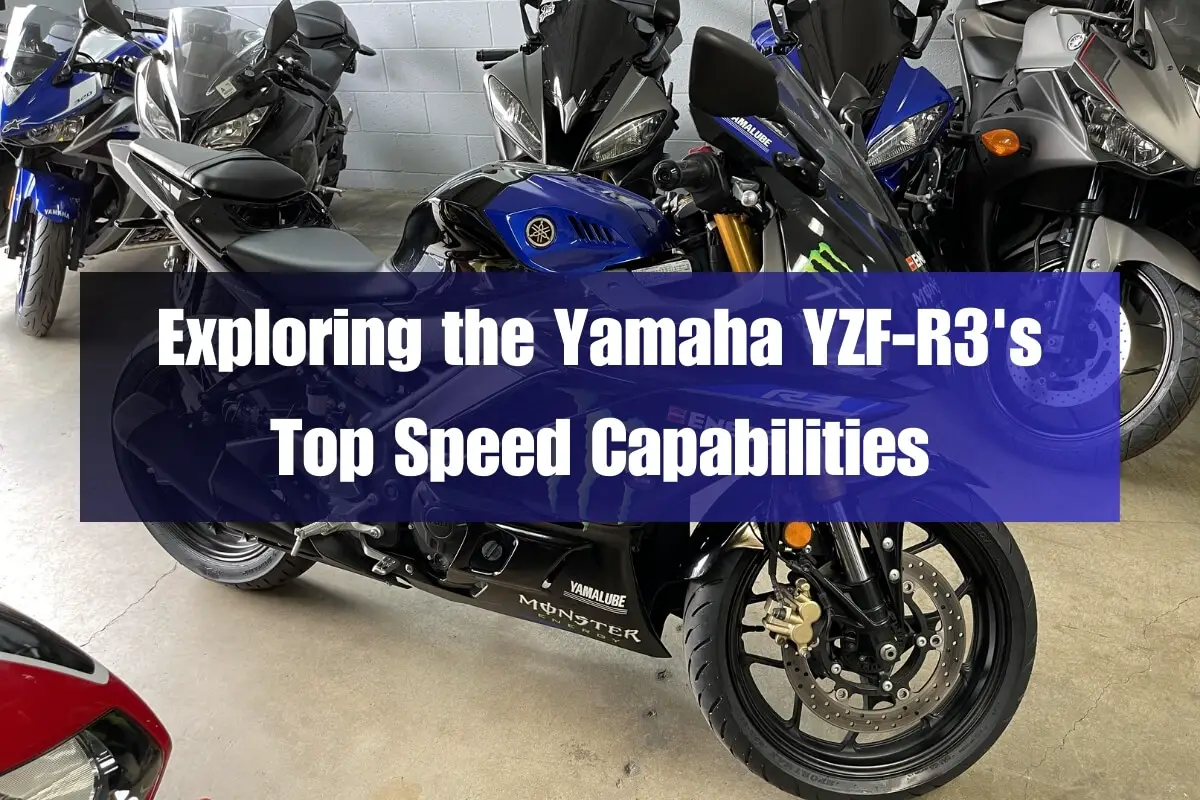
Are you a thrill-seeker searching for an entry-level sportbike that packs a punch? Look no further than the Yamaha YZF-R3, a motorcycle that promises exhilarating speeds while maintaining an approachable and practical demeanor. In this comprehensive guide, we’ll delve into the heart-racing top speed of the 2024 Yamaha YZF-R3, unraveling its performance secrets and exploring what makes this compact machine a true speed demon on two wheels.
2024 Yamaha YZF-R3: An Overview
Before we dive into the nitty-gritty of the YZF-R3’s top speed, let’s take a moment to appreciate the bike’s overall package. This sleek and aerodynamic sportbike is a prime example of Yamaha’s commitment to combining style, performance, and practicality.
Key Features
- Sleek R-Series Styling: Inspired by Yamaha’s MotoGP® YZR-M1 machine, the YZF-R3 boasts flowing bodywork and ergonomics that scream performance.
- High-Revving Supersport Engine: Yamaha’s championship-winning technology delivers a broad spread of power with an exciting high-rpm performance.
- Advanced Suspension: The inverted fork and Monocross rear shock provide exceptional handling, balanced chassis rigidity, and adjustable damping for various road conditions.
- Compact Chassis: With a fully-fueled weight of only 375 pounds and a seat height of 30.7 inches, the YZF-R3 is nimble and confidence-inspiring on city streets and racetracks alike.
- Practical Performance: A range of exclusive technologies ensures the YZF-R3 combines Yamaha’s legendary refinement and reliability with thrilling performance, all while sipping fuel at an efficient 56 mpg.
Specifications Table
| Feature | Specification |
|---|---|
| Engine | 321cc liquid-cooled, 4-stroke, DOHC inline twin-cylinder |
| Bore x Stroke | 68.0mm x 44.1mm |
| Compression Ratio | 11.2:1 |
| Fuel Delivery | Fuel injection |
| Transmission | 6-speed; multiplate wet clutch |
| Final Drive | Chain |
| Suspension/Front | Inverted telescopic fork; 5.1-in travel |
| Suspension/Rear | Monocross single shock, adjustable preload; 4.9-in travel |
| Brakes/Front | 298mm hydraulic disc with ABS |
| Brakes/Rear | 220mm hydraulic disc with ABS |
| Tires/Front | 110/70-17 Dunlop® Sportmax GPR-300F |
| Tires/Rear | 140/70-17 Dunlop® Sportmax GPR-300R |
| Wheelbase | 54.3 in |
| Seat Height | 30.7 in |
| Fuel Capacity | 3.7 gal |
| Fuel Economy | 56 mpg |
| Wet Weight | 375 lb |
The Need for Speed: Exploring the YZF-R3’s Performance
Now that we’ve covered the basics, let’s dive into the heart of the matter: the YZF-R3’s top speed capabilities.
Top Speed: How Fast Can It Go?
According to Yamaha, the 2024 YZF-R3 boasts an estimated top speed of 181 km/h (112 mph). This impressive figure is a testament to the bike’s lightweight yet potent 321cc parallel-twin engine and aerodynamic design.
While top speed is an exciting metric, it’s essential to remember that it should only be explored in controlled environments, such as a racetrack, and with proper safety gear.
Acceleration and Power Delivery
Top speed is just one aspect of the YZF-R3’s performance equation. This nimble sportbike also impresses with its acceleration capabilities, able to sprint from 0 to 100 km/h (0 to 62 mph) in about 6 seconds.
The key to this punchy acceleration lies in the YZF-R3’s high-revving engine architecture, which features a compression ratio of 11.2:1, double overhead cams (DOHC), and four-valve cylinder heads. This design allows the engine to spin up quickly, delivering an exciting surge of power as the revs climb.
Factors Influencing Top Speed
While the engine is undoubtedly the heart of the YZF-R3’s performance, several other factors contribute to its top speed capabilities:
- Aerodynamics: The bike’s sleek, R-series styling not only looks sharp but also minimizes wind resistance, allowing the YZF-R3 to slice through the air more efficiently at high speeds.
- Gearing: The six-speed transmission and final drive ratio play a crucial role in translating the engine’s power into forward momentum, ultimately affecting the bike’s top speed potential.
- Weight Distribution: With a near 50/50 weight distribution, the YZF-R3 benefits from improved stability and traction, enabling it to maintain its speed and composure at higher velocities.
Test Ride Impressions: Putting the YZF-R3 Through Its Paces
While numbers and specifications can tell us a lot about a motorcycle’s performance, there’s no substitute for real-world experience. During our test ride of the 2024 Yamaha YZF-R3, we had the opportunity to push the bike to its limits and truly appreciate its speed capabilities.
From the moment we twisted the throttle, the YZF-R3’s eager engine response was apparent. The bike surged forward with authority, rapidly gaining speed as the revs climbed. The smooth power delivery and linear acceleration made it easy to maintain control, even as we approached triple-digit speeds.
What impressed us most, however, was the YZF-R3’s composure and stability at higher velocities. Despite its compact size and lightweight chassis, the bike felt planted and confidence-inspiring, even when pushing the limits on the racetrack’s straightaways.
Owner Experiences: Rider Reviews and Feedback
While our test ride provided a glimpse into the YZF-R3’s performance potential, it’s essential to consider the experiences of real-world owners who have put countless miles on this machine.
Positive Reviews and Highlights
Many YZF-R3 owners rave about the bike’s thrilling acceleration and top-end performance, praising its ability to deliver an adrenaline-pumping riding experience without overwhelming novice riders.
“The R3 is an absolute blast to ride! It may be a ‘starter bike,’ but the speed and power it delivers are no joke. I’ve had mine up to an indicated 125 mph, and it still had a bit more to give.” – Jake, YZF-R3 owner
“I was hesitant about getting a smaller bike, but the R3’s performance quickly erased any doubts. It’s nimble, rev-happy, and an absolute hoot to ride on twisty roads or the track.” – Sarah, YZF-R3 owner
Criticisms and Areas for Improvement
While the YZF-R3 receives high praise for its performance, some owners have highlighted areas where improvements could be made:
“The brakes could use a bit more initial bite. They’re not bad, but a more powerful setup would inspire even more confidence when riding at high speeds.” – Tom, YZF-R3 owner
“The stock tires are decent, but they can start to lose grip when really pushing the bike’s limits. An upgrade to stickier rubber would be a worthwhile investment.” – Alex, YZF-R3 owner
Pros and Cons Summary
To summarize the owner experiences, here are the key pros and cons of the YZF-R3’s top speed and performance:
Pros:
- Thrilling acceleration and top-end performance
- Eager and rev-happy engine character
- Composed and stable at high speeds
- Well-suited for both novice and experienced riders
Cons:
- Brakes could be more powerful for added confidence
- Stock tires may struggle to maintain grip at the limit
Competitive Landscape: How Does the YZF-R3 Stack Up?
While the Yamaha YZF-R3 is undoubtedly a potent and capable entry-level sportbike, it’s essential to consider how it stacks up against its competitors in terms of top speed and overall performance.
Top Speed Comparison with Rivals
When it comes to outright top speed, the YZF-R3’s claimed 181 km/h (112 mph) places it in a highly competitive position within its class. Here’s how it compares to some of its closest rivals:
- Kawasaki Ninja 400: With a top speed of around 180 km/h (112 mph), the Ninja 400 is neck-and-neck with the YZF-R3 in terms of outright velocity.
- KTM RC 390: This Austrian-built sportbike has a slight edge, boasting a top speed of approximately 167 km/h (104 mph).
- Aprilia RS 660: While larger in displacement, the RS 660 showcases its performance prowess with a claimed top speed of around 225 km/h (140 mph).
It’s worth noting that real-world top speeds can vary due to factors such as rider weight, wind conditions, and the specific bike’s state of tune.
Alternative Options in the Entry-Level Sportbike Segment
While the YZF-R3 is a compelling choice, riders in the market for an entry-level sportbike have several other options to consider:
- Honda CBR500R: With a parallel-twin engine and user-friendly demeanor, the CBR500R is a popular alternative for those seeking a more relaxed riding experience.
- Suzuki GSX-R600: For riders seeking more outright performance, the GSX-R600 offers a significant step up in power and speed, albeit at the cost of increased complexity and a steeper learning curve.
- KTM Duke 390: If you prioritize agility and nimble handling over top-end speed, the Duke 390 is a compelling option with its lightweight trellis frame and upright riding position.
Ultimately, the choice will depend on your specific needs, riding preferences, and budget considerations.
Unleashing More Speed: Modifications and Upgrades
For some riders, the YZF-R3’s factory performance may not be enough, and they may seek to unlock even more speed potential through modifications and upgrades. Here are some popular options:
Performance Exhaust Systems
One of the most common upgrades for the YZF-R3 is a high-performance exhaust system. These aftermarket systems not only provide a more aggressive exhaust note but can also improve power output by reducing back pressure and optimizing exhaust flow.
Engine Tuning and Remapping
Another avenue for extracting more speed from the YZF-R3 is through engine tuning and remapping. By modifying the fuel and ignition maps, experienced tuners can unlock additional horsepower and torque, potentially resulting in improved acceleration and top speed.
Aerodynamic Enhancements
While the YZF-R3 already boasts a sleek and aerodynamic design, some riders opt for additional aerodynamic enhancements to reduce wind resistance further. Options range from aftermarket fairings and windscreens to race-inspired bodywork kits.
It’s crucial to note that modifications and upgrades should only be performed by experienced professionals and that any changes may affect the bike’s warranty and legal compliance.
Pricing, Availability, and Ownership Costs
Now that we’ve explored the YZF-R3’s performance capabilities let’s discuss the practical aspects of ownership.
Pricing and Availability
For the 2024 model year, the Yamaha YZF-R3 carries a manufacturer’s suggested retail price (MSRP) of $5,499 in the United States. This price point makes it an attractive option for riders seeking an affordable entry into the world of sportbikes.
As for availability, the YZF-R3 is readily available at Yamaha dealerships across the country, with deliveries typically occurring in the spring and summer months.
Ownership Costs
Beyond the initial purchase price, it’s essential to consider the ongoing costs of ownership:
- Fuel Efficiency: With a claimed fuel economy of 56 mpg, the YZF-R3 is relatively inexpensive to operate, especially for shorter commutes and city riding.
- Insurance: As an entry-level sportbike, insurance rates for the YZF-R3 are typically lower than those for larger and more powerful models.
- Maintenance: Like any motorcycle, the YZF-R3 will require regular maintenance and servicing, with costs varying depending on your location and chosen service provider.
Overall, the YZF-R3 presents a compelling ownership proposition, offering exhilarating performance and sleek styling at an accessible price point.
Who Should Consider the YZF-R3?
With its blend of performance, practicality, and affordability, the Yamaha YZF-R3 appeals to a wide range of riders. Here are some of the key target audiences for this versatile sportbike:
Novice Riders
The YZF-R3’s user-friendly nature and forgiving power delivery make it an excellent choice for novice riders looking to transition from smaller displacement bikes or those seeking their first true sportbike experience.
Experienced Riders Seeking Affordability and Practicality
Even experienced riders may find the YZF-R3 appealing, particularly those seeking an affordable and practical option for commuting, canyon carving, or occasional track days without the complexity and costs associated with larger sportbikes.
Urban Commuters
With its compact dimensions, lightweight chassis, and fuel efficiency, the YZF-R3 is well-suited for navigating urban environments and cutting through congested city traffic with ease.
Riding School and Track Day Enthusiasts
Many riding schools and track day organizations favor the YZF-R3 for its approachable performance and manageable power delivery, making it an ideal platform for honing skills in a controlled environment.
Ultimately, the YZF-R3’s versatility and broad appeal make it a compelling option for a wide range of riders, from those just starting out to seasoned enthusiasts seeking an affordable and practical sportbike experience.
Common Issues, Recalls, and Fixes
While the Yamaha YZF-R3 is generally regarded as a reliable and well-engineered machine, no motorcycle is perfect. Here are some common issues and recalls to be aware of:
Mild Vibrations
Some owners have reported mild vibrations at around 7,000 rpm, which may be attributed to loose bolts or improper chain adjustment. Addressing these issues through proper maintenance and adjustment can often resolve the problem.
Overheating Concerns
In rare cases, some YZF-R3 owners have experienced overheating issues, which can lead to performance problems and potential engine damage. Proper maintenance, including regular coolant flushes and radiator inspections, can help mitigate these risks.
Brake Pad Issues
A handful of owners have reported premature brake pad wear or issues with brake pad materials. Upgrading to higher-quality aftermarket pads or adjusting the brake caliper pistons may be necessary to address these concerns.
Recalls and Service Bulletins
Like any vehicle, the YZF-R3 has been subject to a few recalls and service bulletins over its production run. It’s essential to stay up-to-date with any outstanding recalls or advisories from Yamaha to ensure your bike is operating at its full potential and to address any potential safety concerns.
While these issues are relatively minor and can often be addressed through proper maintenance and servicing, it’s always best to stay vigilant and address any concerns promptly to ensure a safe and enjoyable riding experience.
Safety and Reliability: A Closer Look
When it comes to high-performance machines like the Yamaha YZF-R3, safety and reliability are paramount. Let’s take a closer look at how the YZF-R3 fares in these crucial areas:
Safety Features
Yamaha has equipped the YZF-R3 with several key safety features to inspire confidence and peace of mind:
- Anti-Lock Braking System (ABS): The YZF-R3 comes standard with an ABS system, which helps prevent wheel lockup and loss of control during hard braking situations.
- Lightweight and Agile Chassis: The bike’s compact dimensions and low weight contribute to its agility and responsiveness, making it easier to maneuver and avoid potential hazards.
- LED Lighting: Both the headlights and taillights utilize bright and long-lasting LED units, improving visibility and conspicuity in all lighting conditions.
Reliability and Durability
Yamaha motorcycles are renowned for their reliability and durability, and the YZF-R3 is no exception. This compact sportbike is built to withstand the rigors of daily riding and occasional track use, thanks to its robust construction and high-quality components:
- Proven Engine Architecture: The YZF-R3’s parallel-twin engine configuration has been a staple of Yamaha’s lineup for years, renowned for its smooth operation, low vibration levels, and impressive longevity when properly maintained.
- Durable Chassis Components: From the diamond-style steel frame to the inverted front fork and adjustable rear shock, the YZF-R3’s chassis components are designed to withstand the stresses of spirited riding while maintaining precise handling characteristics over time.
- High-Quality Braking System: The YZF-R3’s braking components, including the hydraulic discs and ABS system, are engineered to provide consistent and reliable stopping power, even under demanding conditions.
- Corrosion-Resistant Materials: Yamaha has employed corrosion-resistant materials throughout the YZF-R3’s construction, helping to ensure long-term durability and resistance to the elements.
While no motorcycle is immune to potential issues or failures, the YZF-R3 has established a strong reputation for reliability among owners and enthusiasts alike. Regular maintenance and adherence to Yamaha’s service intervals can further enhance the bike’s longevity and ensure many years of trouble-free operation.
Frequently Asked Questions (FAQ)
Even after covering the YZF-R3’s top speed capabilities, performance, and other aspects in detail, some questions may still linger. Here are some frequently asked questions (FAQs) about the Yamaha YZF-R3:
Is the YZF-R3 suitable for highway riding?
While the YZF-R3 is primarily designed for urban and canyon riding, its top speed and overall performance make it capable of handling highway cruising as well. However, extended periods of high-speed riding may result in increased wind buffeting and fatigue.
Can the YZF-R3 be used for track days?
Absolutely! The YZF-R3’s nimble handling, potent engine, and capable braking system make it a popular choice for track day enthusiasts, especially those seeking an approachable and affordable platform for honing their skills.
How does the YZF-R3’s fuel economy compare to larger sportbikes?
With a claimed fuel economy of 56 mpg, the YZF-R3 is significantly more efficient than larger displacement sportbikes, which can translate into substantial savings at the gas pump.
Is the YZF-R3 comfortable for taller riders?
While the YZF-R3’s ergonomics are designed with average-sized riders in mind, taller individuals may find the riding position slightly cramped, especially during extended rides. Adjustable rear sets or a higher handlebar can help alleviate some discomfort.
Can the YZF-R3 accommodate a pillion passenger?
While not explicitly designed for two-up riding, the YZF-R3 can accommodate a pillion passenger for shorter distances. However, the bike’s performance and handling characteristics may be compromised with the added weight.
Is the YZF-R3 a good choice for beginners?
Absolutely! The YZF-R3’s user-friendly power delivery, lightweight chassis, and forgiving handling make it an excellent choice for novice riders looking to transition into the world of sportbikes.
Final Thoughts and Conclusion
As we reach the end of our exploration of the Yamaha YZF-R3’s top speed capabilities, one thing is abundantly clear: this compact sportbike packs a serious punch in terms of performance and exhilaration.
With its claimed top speed of 181 km/h (112 mph) and impressive acceleration figures, the YZF-R3 offers a thrilling riding experience that belies its entry-level positioning. Coupled with its sleek aesthetics, advanced suspension, and practical ownership costs, the YZF-R3 emerges as a compelling choice for riders seeking an affordable and accessible entry into the world of high-performance motorcycling.
Whether you’re a novice rider seeking your first true sportbike experience or an experienced enthusiast in search of an affordable and practical canyon carver, the Yamaha YZF-R3 delivers a winning combination of speed, agility, and practicality.
So, embrace the need for speed, but always remember to ride responsibly, respect the limits of the machine and your own abilities, and prioritize safety above all else. With the YZF-R3 in your stable, the open road beckons, offering an exhilarating ride and the promise of adrenaline-fueled adventures.
